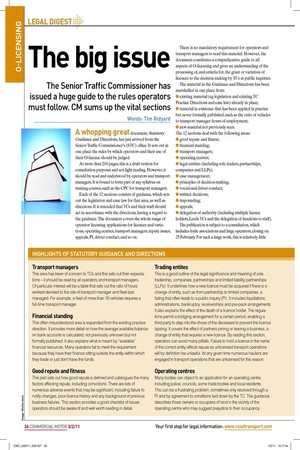HIGHLIGHTS OF STATUTORY GUIDANCE AND DIRECTIONS Transport managers
Page 21

If you've noticed an error in this article please click here to report it so we can fix it.
This area has been of concern to TCs and this sets out their expectations – it should be read by all operators and transport managers. Of particular interest will be a table that sets out the ratio of hours worked devoted to the role of transport manager and fleet size managed. For example, a fleet of more than 15 vehicles requires a full-time transport manager.
Financial standing
This often misunderstood area is expanded from the existing practice direction. It provides more detail on how the average available balance on bank accounts is calculated, not previously unknown but not formally published. It also explains what is meant by “available” financial resources. Many operators fail to meet the requirement because they have their finance sitting outside the entity within which they trade or just don’t have the funds.
Good repute and itness
This part sets out how good repute is defined and catalogues the many factors affecting repute, including convictions. There are lists of numerous adverse events that may be significant, including failure to notify changes, poor licence history and any background of previous business failures. This section provides a good checklist of issues operators should be aware of and well worth reading in detail.
Trading entites
This is a good outline of the legal significance and meaning of sole tradership, companies, partnerships and limited liability partnerships (LLPs). It underlines how a new licence must be acquired if there is a change of entity, such as from partnership to limited companies, a failing that often leads to a public inquiry (PI). It includes liquidations, administrations, bankruptcy, receiverships and pre-pack arrangements. It also explains the effect of the death of a licence holder. The regulations permit a bridging arrangement for a certain period, enabling a third party to step into the shoes of the deceased to prevent the licence lapsing. It covers the effect of partners joining or leaving a business, a change of entity that requires a new licence. By reading this section, operators can avoid many pitfalls. Failure to hold a licence in the name of the correct entity affects repute as unlicensed transport operations will by definition be unlawful. At any given time numerous hauliers are engaged in transport operations that are unlicensed for this reason.
Operating centres
Many bodies can object to an application for an operating centre, including police, councils, some trade bodies and local residents. This can be a frustrating problem, sometimes only resolved through a PI and by agreement to conditions laid down by the TC. The guidance describes those owners or occupiers of land in the vicinity of the operating centre who may suggest prejudice to their occupancy













































